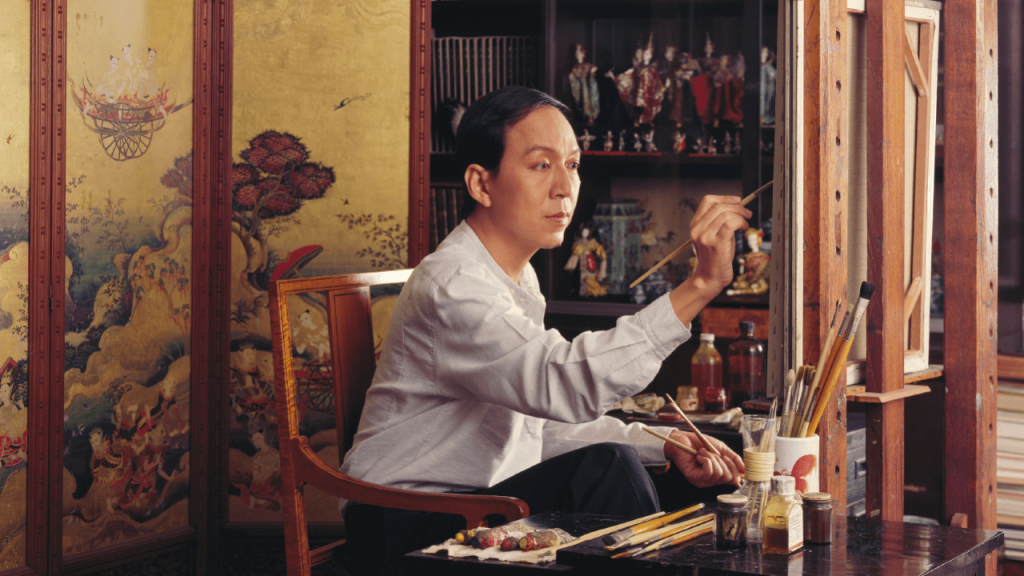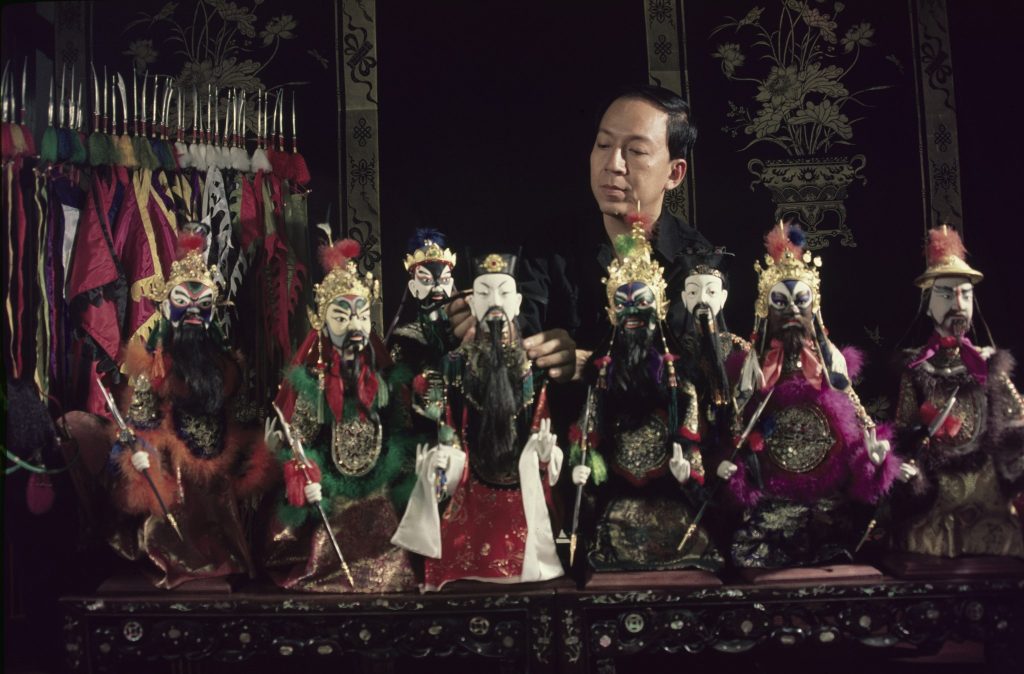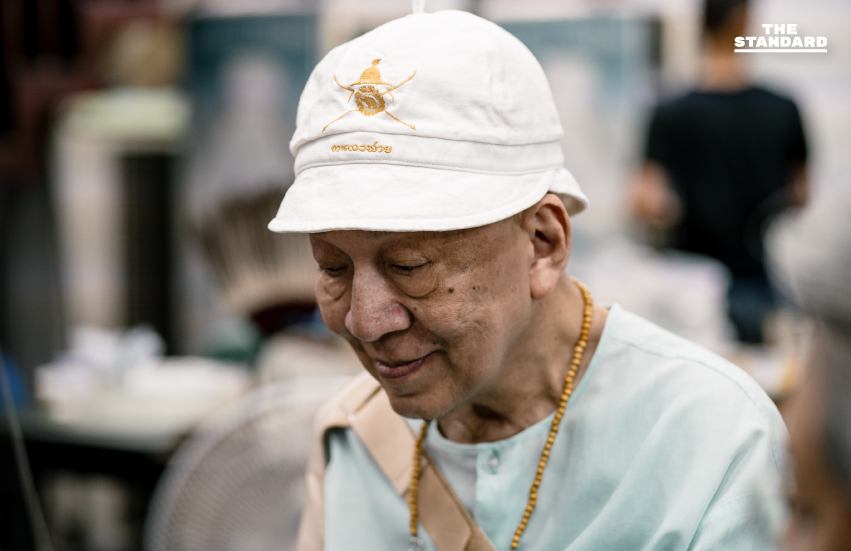Chakrabhand Posayakrit: Master Artist and Craftsman
A prominent figure in Thai art and craftsmanship who plays an important role in the revival of puppetry.

Chakrabhand Posayakrit in his early days [photo: The Momentum]
Recognized as a national artist in the visual arts (painting) fields by the Office of the National Culture Commission of Thailand in 2000, Chakrabhand Posayakrit (จักรพันธุ์ โปษยกฤต) is a renowned artist both at home and abroad, with his signed originals sought after by collectors around the globe. Few, though, are fortunate enough to have the opportunity to own one.
Chakrabhand certainly deserves the honor of National Artist. However, his contribution to Thai arts is far greater than just the body of his paintings. For the last few decades, he has devoted much of his time to Thai puppetry, a discipline that covers many branches of Thai arts from traditional painting and crafts to performing.
A student of Professor Silpa Bhirasri (born Corrado Feroci)–the father of modern art in Thailand and founder of Silpakorn University–Chakrabhand earned his bachelor’s degree in Fine Arts from the university’s Faculty of Painting, Sculpture, and Graphic Arts in 1968.
Like a Chicken Laying Eggs
Born in Bangkok at the end of World War II, Chakrabhand developed an interest in art at a very young age. “I was ‘writing pictures’ even before I started writing kor kai (the first letter in the Thai alphabet, equivalent to A),” he recalled.
The artist is considered one of the country’s greatest painters with a number of his works winning awards at the national art competitions. But what has made him most famous are his unique and numerous works meshing traditional Thai art with modern aesthetics.
Commenting on the quantity of his paintings, he once said: “I feel like I do it like a chicken lays eggs… and keeps laying eggs.”
The women in Chakrabhand’s paintings are known for their delicate beauty whether they are drawn from literature, drama, or mythical creatures, such as the Kinnaree which is a Buddhist and Hindu mythical half-bird, half-human. Most of these images are reproduced annually and sold to raise money for charitable organizations during New Year.
He is also known for portraits as well as illustrations of Thai literary works, among them Inao, a folk tale originating from the Island of Java Indonesia, which he drew for Thai Wattana Panich Publishing House in 1967 and for local folk tales in Muang Boran (the Ancient City) magazine in 1977.
Chakrabhand is also recognized as a master of the mural painting, a traditional art form that often adorns the walls of ubosots (ordination halls) in Thai temples. Chakrabhand’s mural paintings can be seen at the new ubosot of Trithosathep Worawihan Temple in Bangkok and Wat Khao Sukim, Tha Mai District, Chanthaburi Province in Thailand’s East. The works of Chakrabhand and his disciples are widely considered to represent a new school within the Thai craftsmanship tradition. Today, the Chakrabhand lineage of craftsmanship is revered as one of the most important movements that defined the Artscape during the reign of His Majesty King Bhumibol Adulyadej (Rama IX: 1946-2016).
A bookworm by nature, Chakrabhand is also a talented writer who in the past contributed columns to Lalana women’s magazine under the pen name Sasiwimol, as well as to Ploygampetch magazine. His writings have been compiled into a number of pocket books
Reviving Thai Puppetry
Chakrabhand has always loved Thai traditional art and classical dance. In 1955, as a student at the private all-boys boarding school Vajiravudh College, he saw puppets for the first time on TV. He was so impressed by the puppet show telling the story of Phra Aphai Mani, an epic poem by the great poet Sunthorn Phu (1786-1855), that he started making his own rod puppets from materials around him, such as broken paintbrushes and chopsticks.
Inspired even more after watching a play at the Fine Arts Department, he immediately started to build his own theater out of bread boxes with some decorations of painted backdrops. He also filled his little project with small, sparkling dolls. “I came up with a story and played it,” recalled the gentleman, “It was lots of fun.”
His love for hun krabok (Thai rod puppets) never faded away. After he graduated, he worked as a guest lecturer at the Faculty of Decorative Arts at Silpakorn University. There, he came to know Chuen Sakulkaew, a National Artist in traditional puppetry. She agreed to train him in the art of hun krabok, and he later followed up by learning to make and restore puppets. Before long, enhancing the craft with his artistic talents, he had created a series of his own puppets.
And so the Chakrabhand Posayakrit Puppet Troupe was born. In 1975, the troupe made its debut at the National Theater with the play “Phra Aphai Mani: Escape from the Sea Ogress.” His first performance led him to meet and gain additional knowledge from Wong Ruamsuk, another puppet master from Amphawa, Samut Songkhram province.
Two years later, in 1977, the Chakrabhand Posayakrit Puppet Troupe performed an episode from the Ramakien Epic, the Thai version of the Hindu Ramayana Epic, at Suan Pakkard Palace in Bangkok. By then, he was also learning traditional Thai embroidery from Grandmaster Yuean Phanuthat.
Royal Puppetry
Chakrabhand’s hard works and determination have long been evident. In 1982, Professor Chot Kalayanamit praised Chakrabhand for being recognized as one of the 52 master craftsmen in the past 200 years of the Rattanakosin era (1782-1982). He said that Chakrabhand deserved it: “He can see the sweet beauty in Thai art and culture deeply … [and] is another important person who devotes his life to the conservation of art and culture. As we have seen, this person has promoted the creation and performance of Thai puppetry to the public by making it more interesting. It is expected that he will be able to produce more works of art for the nation.”
Chakrabhand’s interest in Thai puppetry continued and led him to restore the deteriorating royal puppets in 1983. The large puppets, almost one metre tall, with intricate threads for the movement of hands, arms, and legs were tucked away in a dusty exhibit at the Bangkok National Museum. No living soul had ever seen this kind of primitive theatre. Moreover, no one knew how to draw a royal puppet anymore.
Chakrabhand and his team spent much time and effort on the project, gradually learning the workings of the mechanism, as well as injecting new life into the royal puppets. They succeeded in restoring five puppets as well as creating a set of elaborate costumes and accessories. The work was completed in 1986. Concurrently, his research on the history of various puppets in Thailand was also published in a book form.

Chakrabhand with his hun kraboks [photo: The Chakrabhand Posayakrit Foundation’s Facebook page]
A new challenge arose in 1988. Recreating The Romance of the Three Kingdoms with his new sets of puppets, Chakrabhand staged a Hun Krabok show based on the “Battle of the Red Cliff” episode. Music, lyrics, and dialogue were also rewritten exclusively for the show. The performance received critical acclaims and managed to garner positive reviews from MR Kukrit Pramoj, former Prime Minister and one of Thailand’s leading thinkers.
“I have never seen any puppet that is as noble as the puppet of Mr. Chakrabhand… This puppet show lasted 3 hours, but I didn’t see a minute of these 3 hours as a waste, because I was blessed to be entertained, and have been inspired more than at any other time in my life,” the former premier wrote in the daily Siam Rath newspaper.
From 1993 to 1997, Chakrabhand took on the job of restoring the Wang Na puppets (Thai puppets in the Ramayana series) formerly owned by Krom Phra Ratchawang Bovorn Vichaicharn, a viceroy during the reign of King Rama V (1868-1910). The puppets were wrecks. He had to assemble all the parts together, repair the strings, and restore the costumes. The results can be seen in the beautiful puppets displayed at the Thaksina Phimuk Throne Hall in the Grand Palace nowadays.
Taleng Phai Puppet Show
Over the past two decades shortly after the Three Kingdoms puppet series in 1990, Chakrabhand devoted his time and strength to preparing the Taleng Phai puppet performance.
“Taleng Phai” (ตะเลงพ่าย) is a heroic epic recounting the struggle of King Naresuan the Great of Ayutthaya to liberate his kingdom from Burma. Lyrics and scripts have had to be rewritten based on the original version. In this regard, Chakrabhand’s protégé Vallabhis Sodprasart, also deputy director of the Chakrabhand Foundation, has been in charge of script-writing just as he was with the Sam Kok performance. When completed, there will be about 200 puppets including King Naresuan, Phra Suphan Kanlaya (King Naresuan’s sister), Burmese Phra Maha Uppa Raja and Burmese troops for the four-hour Taleng Phai performance.
Three National Artists in the fields of Thai music and dance, namely Master (Khru) Boonyong and Master (Khru) Boonyang Ketkong and Master Chamnian Srithaiphan, are in charge of singing, just as they have been for other shows put on by Chakrabhand.
Apart from making puppets, each with exquisite details, the performers also have to be trained in classical Thai dance. People from all walks of life and different backgrounds joined the dance, exhibiting their faith in the master of puppetry. As new puppets were completed, new scenes were added. The longer rehearsals took, the more crowded the audience became. Word of mouth spoke of the beauty of the puppets, the miracle of the dance, and the melodiousness of the songs that brought so much joy to those who watched.
Passing the Torch

Chakrabhand [photo: The Standard]
The bad news came in 2009 when a developer wanted to erect a high-rise, 32-storey condominium right next to Chakrabhand’s home. The planned development worried him due to the fragility of his collection of more than two hundred puppets, some of which are centuries old. Although he received support and the developer finally backed off, he came to realize that he would eventually have to find a place to store and display his work properly–a full-scale museum.
Chakrabhand finally found a plot of land in Sai Mai on the outskirts of Bangkok, to which the Chakrabhand Foundation would relocate. As a result, the puppet’s new home will provide him with the space to treasure his collections and stage any shows, as and when he wishes.
******************************
Reference
Thongparn, Sarun. Chakrabhand Posayakrit Silpin Lae Silpa Samai Ratchakarn Tee Kao [Chakrabhand Posayakrit: An artist and his artistry during the Ninth Reign]. Watthanatham Journal: Department of Cultural Promotion, vol. 51, no. 1, April-June 2012, p. 70-80. Available at http://magazine.culture.go.th/2012/1/files/assets/common/downloads/culturemag2012-1.pdf.


